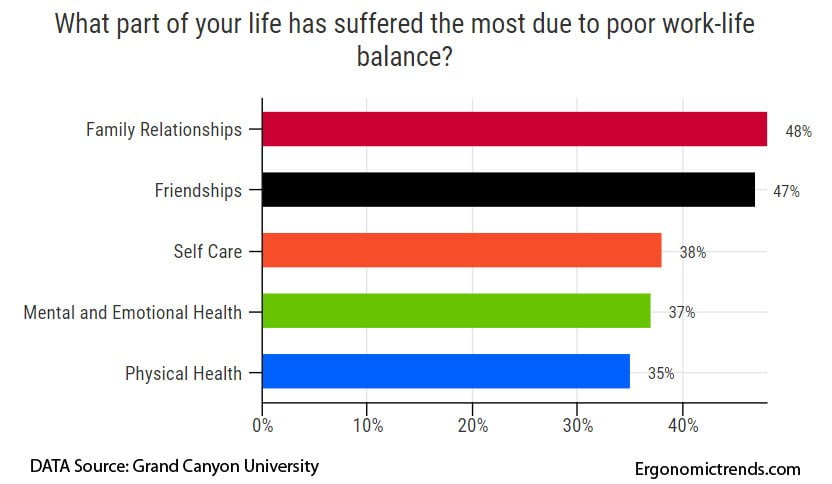
The term balance holds great significance. It is often interlinked with every aspect of life. Increasing work demand and a shift in the work culture from a traditional office to a virtual setup have forced professionals to juggle managing their work-life balance.
“Balance is not better time management, but better boundary management. Balance means making choices and enjoying those choices.”– Betsy Jacobson
The rise of the IT revolution and technology has enabled ample work-related resources that are easily accessible, but they are also diminishing personal time. A demanding job and tiring work schedule are challenging to handle and impact the work-life balance.
More than 60% of American workers perceive their work-life balance as askew. Many individuals often struggle to balance their work and personal lives perfectly, feeling stressed and overburdened.
An organized workspace also impacts achieving a balance between work and personal life. It demonstrates having a designated working space, which promotes having a fixed and focused work hour duration, resulting in a seamless transition to relaxation afterward.
Understanding the Importance of Work-Life Balance
Maintaining a balanced diet for sustained health and achieving work-life balance requires diversity, i.e., a mix of activities and rest. It’s a common misconception that we can be constantly productive or that an eight-hour workday equals eight hours of output, often unattainable for many.
Overworking has several negative consequences, including higher risks of burnout, fatigue, stress-related health problems, and decreased productivity.
“Never get so busy making a living that you forget to make a life.”– Dolly Parton
Research indicates that professionals working 55 hours a week are at a higher risk of getting a heart attack, anxiety, and depression. Other factors of declining physical health include lousy sleeping habits and long hours.
As the term implies, work-life balance affects all aspects of one’s life but manifests differently for each person.
Here are some signs of an unhealthy work-life balance include:
1. Excessive Work
It means working consistently for long hours, even during personal time, which includes weekends and holidays. This way, the employee will need more time for rest, relaxation, or personal activities, resulting in physical and mental exhaustion.
2. Neglected Personal Life
Prioritizing work above everything results in a neglected personal life. Sacrificing personal relationships, hobbies, and leisure time to work exhausts and creates several problems.
3. Burnout
Suffering physical, mental, and emotional exhaustion from chronic stress and workplace pressure often results in burnout. According to a report, 89% of employees have experienced burnout within the past year.
4. Lack of Self-Care
Failing to prioritize self-care activities like exercise, adequate sleep, and leisure time results in declining physical and mental health.
5. Strained Relationships
Getting excessively devoted to work-related commitments and neglecting family, friends, and loved ones. Failing the near and dear ones causes a rift, and it can be tough to maintain healthy relationships with them.

7 Actionable Strategies for a Successful Workstation
Regular experimentation is the only way to achieve balance. Managing each day can be challenging but becomes more manageable with time. Listen to your inner compass and optimize your workstation to find your ideal balance. With intention and creativity, you can reset your work-life equilibrium.
Here is a list of seven strategies to create a well-designed workstation to improve your work-life balance:
#1. Designated Work Zones and Leisure Zones
In our modern lives, where many of us work from home or have flexible work arrangements, the concept of “Designated Work Zones and Leisure Zones” has gained significant importance.
It is an approach that involves creating distinct areas within your living or working environment for specific purposes: one for work-related tasks and the other for relaxation and personal time.
Let us understand the importance of separating work and relaxation space:
- Mental Separation: Separating the work and leisure zones creates a clear mental boundary. Your workspace will be where you can focus on your work, while your leisure area is a place to relieve work-related stress, promoting relaxation.
- Minimizing Distractions: A designated workspace minimizes disruptions. It helps in building concentration and streamlining the work. You can focus on tasks and resist non-work activities during working hours.
- Work-Life Balance: A balance helps create a distinct equilibrium between work and personal time. It helps separate personal time from work intrusion while ensuring your leisure space remains a place for relaxation.
#2. Investing in Ergonomic Furniture
Investing in ergonomic furniture has several health benefits. It creates a cozy workspace where employees can work comfortably for longer. This pain-free workspace results in increased efficiency and streamlined workflow.
Yes, ergonomic furniture can be heavy on pockets initially, but they have long-term value as they ultimately contribute to your overall well-being.
Here are some of the health benefits:
- Better Posture: Ergonomic furniture supports a natural posture, reducing the risk of musculoskeletal issues.
- Less Discomfort: Adjustable features minimize discomfort during work.
- Improved Circulation: Ergonomics can enhance blood flow and reduce the risk of numbness during prolonged sitting.
Enhanced Focus: Ergonomic comfort keeps you energized and focused, leading to higher productivity.
#3. Optimal Lighting and Ventilation
Proper lighting and ventilation are necessary for creating a healthy workspace. It also influences the mood. If there is poor lighting, employees cannot focus and will take more prolonged hours to complete their work.
Therefore, optimal lighting and ventilation help in creating a positive atmosphere. Also, having natural light uplifts enhances concentration, making the workspace more pleasant. An airy workspace improves physical and mental health by providing proper ventilation by filling the room with oxygen.
#4. Incorporating Nature and Greenery
Greenery and natural elements soothe and relax the mind, and adding them to the workspace will help improve the mood and relieve stress. Bringing a touch of the outdoors indoors for a more serene and rejuvenating environment helps create a healthier space.
It is a new healthy way to effectively work by lowering stress levels and getting mental clarity, boosting productivity. The workload will be easily managed as productivity improves, giving me time for personal life and leisure activities.
#5. Regular Breaks and Movement
Working continuously without taking breaks and incorporating physical movement into your work routine will tire out the person quickly. It is encouraged to take breaks and follow methods like the Pomodoro Technique that have similar effective strategies.
Breaks and exercise contribute to this balance by:
- Refreshed Focus: Following methods like the Pomodoro Technique involve working for a set time (e.g., 25 minutes) and then taking a short break (e.g., 5 minutes). This method of taking short breaks will allow the brain to rejuvenate and return to the task with a fresh mind.
- Stress Reduction: Taking time off between work and physical moments helps prevent stress and burnout. This way, you can reduce tensions and improve your mental well-being.
- Improved Creativity: Breaks stimulate creativity and give a fresh perspective on work. A rejuvenated mind helps in providing new and innovative ideas.
- Enhanced Work-Life Balance: Restructuring work with regular intervals creates boundaries between personal life and work. Having a dedicated time for both work and personal life reduces the risk of getting overworked and creates a balance between both.
#6. Personalizing the Space
Working in the same old workspace can be tedious and tiring. Giving it a bit of My Space touch can elevate the mood and provide inspiration to work effectively.
This workspace will resonate with you and uplift your mood, improving your performance and productivity. Adding motivational quotes, photographs, or artwork such as custom canvas prints can give it a personalized touch.
Also, it is mandatory to keep this personalized workspace clean and clutter-free. It will help reduce distractions and build a well-systematic atmosphere to focus on tasks.
As a result of managing work effectively, you will have a well-distributed timeline that will help you maintain an equilibrium between your professional and personal life. It will also boost your performance and productivity.
#7. Managing Technology and Setting-Up Boundaries
Understanding the technology and boundaries is essential in managing work-life balance. This includes getting acquainted with work management solutions.
Here are some suggestions that may be of help:
- Scheduled Digital Engagement: Having a designated time assigned for handling social media and emails minimize distractions. This way, you can focus on your personal life and work.
- Digital Detox Breaks: Taking breaks to disconnect from technology is imperative for mental well-being, recharging, and nurturing relationships. These breaks can include evening intervals or a short retreat. This procedure ensures that technology does not take over life but complements it so that a balanced work-life dynamic is maintained.
Contemplating the Influence of Having a Well-Balanced Work Ecosystem
Remote work promises an impeccable work-life balance, but there are also challenges. You must juggle your career with multiple distractions and blurred work hours. A study showed before COVID-19, 20% of Americans worked remotely; now, it’s nearly 70%. Office premises now comprise gyms, schools, dining areas, and bedrooms.
“Don’t confuse having a career with having a life.”– Hillary Clinton.
Working from home has many perks, like ditching commutes and handling chores. Yet, multitasking in the same space diminishes the work and leisure boundaries. The first step in rectifying this issue is identifying the relationship between work and home life. It is not easy to accomplish a single day or by indulging in weekly habits, but such initiatives make a significant difference in the long run.
Working on creating a practical workstation helps in achieving a balance. It will make life easier. Also, integrating an employee time tracking and management solution will tremendously facilitate work-life balance and increase productivity. The solutions help manage time efficiently by prioritizing tasks, staying focused, and setting clear work-life boundaries.
One such solution that is trusted by most businesses is Traqq. Traqq monitors and optimizes work hours efficiently, which enhances the ability to allocate time to work and leisure. It analyzes the workforce’s work habits, enabling data-driven decisions and ensuring employers effectively utilize work hours while maintaining personal time.
Does Traqq look intriguing to you? Want to learn more about this employee time tracking and management solution to help you create a perfect work-life balance?
Then, visit our website or write to us. Our expert will contact you and help you discover how to create a harmonious work-life balance with us.
Author
Aryan Jalan, a professional SEO consultant boasting five years of expertise, is dedicated to driving marketing success for businesses. An avid learner, he blends work with leisure, exploring books and new destinations.

